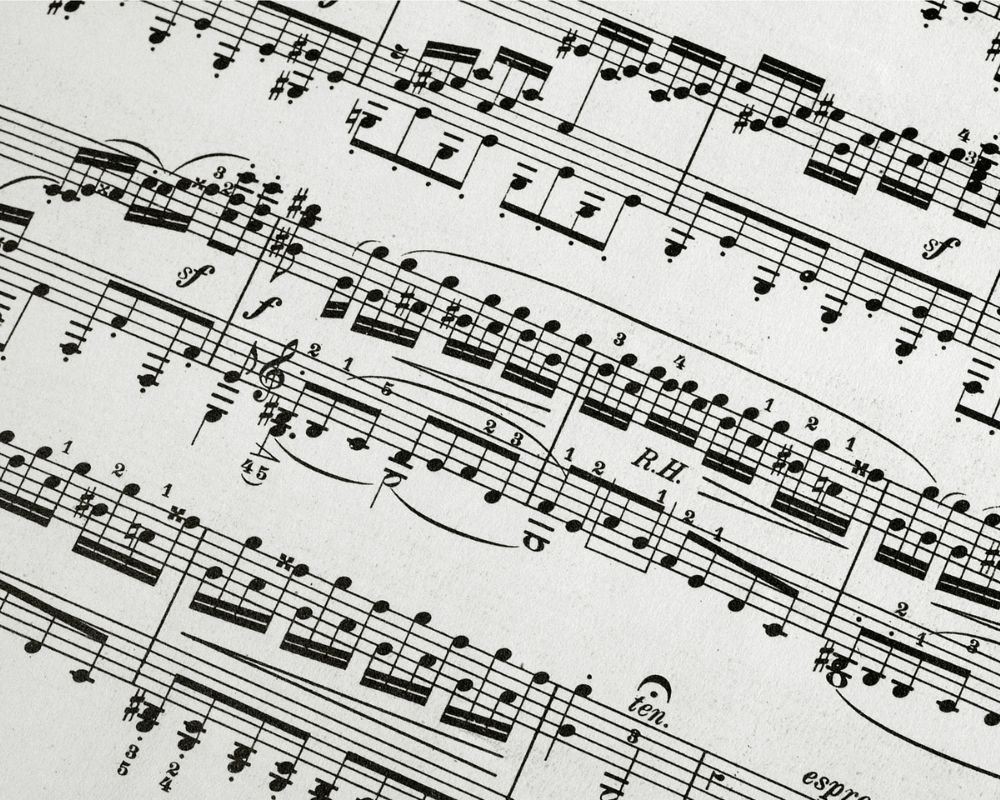Learn to play the solfeggio: 5 practical and fun tips
Would you like to take up music or perfect your instrument? Learning music theory can seem daunting at first, but there are a few tricks you can use to turn a boring lesson into a fun one, and above all, keep motivated. Whether you're a beginner or an amateur musician wishing to reinforce your basics, whether you play guitar, piano or violin, discover 5 practical tips for learning music theory in a simple and fun way. With Newzik, you'll learn to decipher your sheet music in no time!
What is solfeggio?
Solfeggio is the set of rules and notations used to represent and understand music in written form. It's an essential skill for any musician, whether playing an instrument, singing or composing. To master music theory, you need to start by understanding its purpose. Learning solfeggio is all very well. But understanding how it works, and how to use it effectively in music, is even better!
Musical notes
Musical notes are at the heart of music theory. Each note has a name and a value (C, D, E, F, G, A, B), which are then repeated in different octaves. It's through these symbols that melody and harmony come to life on a score.
Musical keys
Musical clefs are used to determine the pitch of notes, and indicate which lines and spaces on the staff correspond to which notes. The most common clefs are :
the treble clef, used for high-pitched voices and instruments such as the piano or guitar,
the Bass clef, used for bass voices and certain low string instruments,
the Alto clef, used mainly for cello and trombone.
🎹 Did you know? The piano uses treble clef and Bass clef. In most scores, treble clef is used for the right hand and Bass clef for the left. However, this can change depending on where the musician is playing on the keyboard. For example, if he plays only high notes with both hands, both staves can be switched to treble clef.
Reading rhythms
Rhythm reading concerns the duration of notes and rests in music. Each note has a specific duration, which can be represented by rhythmic figures such as quarter notes, eighth notes, white notes, etc. Understanding rhythms enables you to play or sing music with precision, respecting the tempo and pauses indicated in the score.
Is studying music theory a prerequisite for playing a musical instrument?
Solfeggio is the subject of much debate among musicians and pedagogues. Although some believe that one can play an instrument without mastering it, it offers some significant advantages for professional musicians. Solfeggio provides a solid foundation for understanding music theory, interpreting scores accurately and communicating with other musicians.
Solfeggio: an easy game?
L'he learning of music is often easier for children, whose brains absorb new knowledge more easily. However, with the right approach and a healthy dose of motivation, adults too can learn music theory with regular practice and the right lessons. And if you're still not convinced, here are 5 good reasons to take up music as an adult!
Can you learn solfeggio on your own?
Yes, many musicians have succeeded in learning music theory without the help of a teacher or music school. However, self-taught music theory requires rigor, motivation and regular practice.
Taking music theory lessons with a music teacher allows you to benefit from :
personalized advice,
immediate corrections in case of error,
constructive feedback to help you move forward,
encouragement,
real support, whether in solfeggio theory or instrument practice.
Are you a music teacher? With NewzikEducation share, modify and annotate your scores with your students, in real time, even when you're teaching from a distance! With Newzik, your students will never find your lessons boring again!
5 fun ways to learn music theory
Choice of learning method: traditional course or modern training?
Whether you opt for traditional music theory lessons or a more modern approach, choose the learning method that suits you best and your daily life and musical goals.
Traditional method
The traditional method of learning solfeggio emphasizes the reading of scores, the study of theoretical rules and the practice of classical exercises. It is based on a structured approach, in which students learn to recognize notes, rhythms, scales and intervals, as well as the various rules of music notation. Traditional music theory courses are taught by a music teacher and have long been used in music schools and conservatories.
Modern method
The modern method of learning solfeggio takes a more playful, interactive approach, adapted to the evolution of technology. It uses applications software and digital tools to make learning music theory more fun and accessible to all. This approach encourages learning through practice and musical experience.
| Traditional method | |
|---|---|
| Benefits | Solid foundation: provides a solid grounding in music theory and a thorough understanding of music. Rigor: the traditional method is renowned for its rigor and precision in learning music theory. Preparation for classical music: particularly suited to those who wish to concentrate on classical music and play works by classical composers. |
| Disadvantages |
Sometimes lacks creativity: some musicians find this approach a little rigid and off-putting, as it emphasizes learning the rules rather than musical creativity. Longer learning time: the traditional method may require more time to master the concepts of music theory, especially for beginners. |
| Modern method | |
|---|---|
| Benefits | More engaging: the use of interactive technologies makes learning more stimulating, fun and motivating. Autonomous learning: the modern method allows students to learn at their own rythm and practice at any time using digital tools. More suited to different musical styles: more suitable for musicians interested in different musical styles outside classical music. |
| Disadvantages |
Lack of a solid foundation: the modern approach may lack theoretical rigor for some musicians. |
Learn solfeggio with fun exercises
Think learning music theory can't be fun? What if we proved you wrong? Rather than seeing learning as a tedious task, turn the experience into a fun and motivating game.
Nowadays, there are many online applications and educational games dedicated to music theory. These interactive tools allow you to review and learn solfeggio in a different way. Whether it's a question of recognizing notes, deciphering scoresreviewing scales or practicing rythm, these applications add a playful dimension to learning. Revise where you want, when you want and at your rythm !
🎶 Another tip for motivating yourself to practice solfeggio exercises: practice to music you love.
💡 The right idea: find mnemonic tricks to memorize your solfeggio lessons! Having trouble remembering the notes on a staff or the order of sharps in the scale of C major? Associate notes with words or images to visualize them mentally, or create musical phrases to remind you of solfeggio rules.
Learning while having fun? That's also the credo of Maxime Proixmusic education and choral singing teacher, who took part in our interview!
Be regular and patient in learning solfeggio
Learning music theory takes time and perseverance. Progress at your own pace rythm and set realistic short- and long-term goals. The secret of successful learning is regularity.
For beginners, start with simple scores and progress slowly. Work on pieces of music adapted to your level, and concentrate on one concept at a time: first recognizing notes, then reading rythm, interpreting nuances, etc.
If you're not taking music theory lessons with a teacher, plan practice sessions in your diary. Every day, devote a few minutes to reading sheet music, practicing rythm, memorizing notes or revising your piano scales.
Is learning music theory proving more difficult than you expected? Stumbling over an exercise? Don't be discouraged if certain solfeggio notions take longer to assimilate. It's perfectly normal. Persevere, stay motivated and celebrate every step forward.
Combining theory and practice
Immerse yourself in the practice of a musical instrument while studying music theory, gives you a concrete understanding and practical application of music theory.
By playing an instrument, you can put the theoretical notions of music theory you've learned in class directly into practice. For example, when you play a melody on a piano, you visualize the notes on the score and associate them with the keys on the keyboard, thus facilitating understanding and memorization between theory and practice.
At the same time, learning music theory reinforces the analysis and understanding of the pieces played. Understanding the harmonic structure, chords, rhythms and nuances present in the score enables you to interpret the music with greater sensitivity and expression.
Developing your musical ear
The musical ear is the ability to hear, identify and understand sounds. By developing your musical ear, you can improve your perception and interpretation of music. Want to develop your musical ear? Practice active listening. By listening carefully to music, whether it's a guitar solo or a piano piece, you'll learn to identify notes, chords, rhythms and nuances.
Start by listening to individual notes and trying to identify them. Then practice recognizing the intervals between two notes. With these simple exercises, you'll be able to identify notes more easily when reading sheet music or playing your instrument.
Finally, vary the styles of music you listen to. Each musical genre offers unique characteristics in terms of notes, chords, rhythms and structures. Jazz, rock, classical music, explore musical genres and have fun identifying the solfeggio elements specific to each style, then integrate them into your practice!
Learning solfeggio can seem a real challenge at first, but don't worry, with a few tricks and diligent practice, you'll soon master the musical symbols on your sheet music. Remember, the key to success is to have fun and never give up!
🎶 With the Newzikinteractive sheet music player, access all your sheet music wherever you are. At home or during lessons with your teacher, find your scores saved in the cloud of the Newzik application and annotate them directly with your comments. Let's play!

